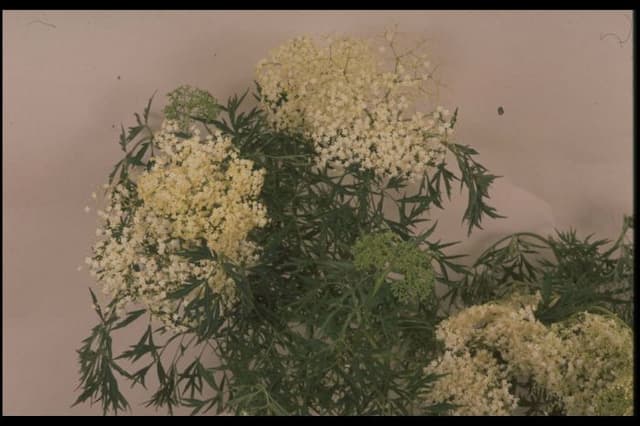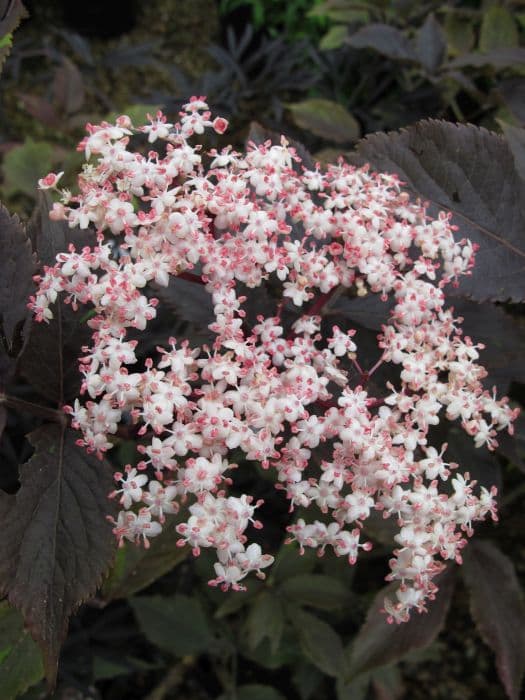Doublefile Viburnum Viburnum plicatum f. plicatum 'Grandiflorum'

ABOUT
The Viburnum plicatum f. plicatum 'Grandiflorum', commonly known as Doublefile Viburnum, is a highly ornamental shrub renowned for its striking, symmetrical growth pattern and exceptional seasonal interest. The plant features layers of horizontal branches that create a tiered, almost pagoda-like form, giving it a distinctive structured appearance that is as stunning in winter as it is when in full leaf. During the spring, the Doublefile Viburnum becomes a spectacle of bloom. It boasts large, lace-cap-like flowers – sterile blooms surrounding a center of smaller, fertile blossoms. The flowers themselves are pristine white and almost resemble snowballs, providing a dazzling contrast against the deep green, neatly pleated leaves. The foliage is oval-shaped with a pointed tip and has a tendency to turn to beautiful shades of burgundy or reddish-purple in the fall, adding to the plant's multi-season display. Beyond its visual appeal, the plant is also appreciated for its production of small, red berry-like fruits that mature to a glossy black. These fruits can attract birds and wildlife to the garden, providing an extra layer of interest beyond the ornamental features. The Doublefile Viburnum's natural elegance makes it a cherished choice for landscapes where it serves as a specimen, in borders, or as a deciduous hedge, bringing beauty and life to any garden setting.
About this plant
 Names
NamesFamily
Adoxaceae.
Synonyms
Japanese Snowball, Doublefile Viburnum.
Common names
Viburnum plicatum var. grandiflorum.
 Toxicity
ToxicityTo humans
Japanese Snowball is considered to have a low level of toxicity to humans. Although severe reactions are rare, ingestion of parts of the plant may cause mild stomach upset, nausea, and vomiting. It is not generally considered dangerous, but it is advisable to seek medical attention if symptoms occur after ingesting any parts of the Japanese Snowball.
To pets
Japanese Snowball is also considered to have a low level of toxicity to pets. If pets consume parts of the plant, they might experience mild gastrointestinal upset, including symptoms such as vomiting or diarrhea. While it's not typically life-threatening, it's a good idea to contact a veterinarian if you suspect your pet has ingested Japanese Snowball, especially if they display any concerning symptoms.
 Characteristics
CharacteristicsLife cycle
Perennials
Foliage type
Deciduous
Color of leaves
Green
Flower color
White
Height
8-10 feet (2.4-3 meters)
Spread
6-8 feet (1.8-2.4 meters)
Plant type
Shrub
Hardiness zones
5
Native area
Japan
Benefits
 General Benefits
General Benefits- Ornamental Appeal: Doublefile Viburnum offers a high ornamental value with its stunning, large white blooms in spring and its layered horizontal branches, adding beauty to landscapes.
- Wildlife Attraction: It attracts a variety of wildlife including birds who feed on its berries and butterflies that are drawn to its flowers.
- Seasonal Interest: This plant provides year-round interest with flowers in spring, red berries in summer, and red to purple foliage in fall.
- Shade Tolerance: Doublefile Viburnum can grow well in partial shade, making it versatile for different garden spots.
- Privacy Screen: When planted in a row, it can function as a privacy screen or hedge, providing a natural barrier with aesthetic appeal.
- Low Maintenance: Once established, it requires minimal care, making it a good choice for gardeners seeking low-maintenance landscaping options.
- Hardiness: The plant is relatively hardy and can tolerate a range of climatic conditions, which makes it suitable for different hardiness zones.
 Medical Properties
Medical Properties- Antipyretic: The plant has been traditionally used to reduce fever.
- Antispasmodic: It may help relieve muscle spasms.
- Sudorific: Can induce sweating to potentially reduce fevers.
 Air-purifying Qualities
Air-purifying QualitiesThis plant is not specifically known for air purifying qualities.
 Other Uses
Other Uses- Photography Backdrop: The large, showy blooms of the Japanese Snowball make a beautiful natural backdrop for garden photography and outdoor portrait sessions.
- Wedding Decor: Its elegant white flowers can be used as decoration in springtime weddings, either in the ground or cut for arrangements.
- Educational Tool: Botany students can study the plant's intricate flowers and branching pattern as an example of deciduous shrub growth habits and floral structures.
- Craft Supplies: The woody branches can be harvested and dried for use in making wreaths and other decorative crafts.
- Insect Habitat: When planted in a garden, it can act as a habitat for beneficial insects, providing shelter and food resources.
- Culinary Garnish: Although not commonly consumed, the blooms could potentially be used as an ornamental garnish for special dishes, after ensuring they are safe and pesticide-free.
- Privacy Screening: When planted in rows or clusters, it forms a thick, lush barrier ideal for privacy screens or living fences.
- Landscape Design: Its symmetrical form and attractive foliage can be used by landscapers to create focal points in garden designs.
- Bonsai Specimen: With careful pruning, the Japanese Snowball can be trained into a bonsai for an elegant indoor or outdoor display.
- Bird Watching Attraction: The shrub can attract birds that feed on the insects found among the branches, providing an opportunity for bird watching.
Interesting Facts
 Feng Shui
Feng ShuiThe Doublefile Viburnum is not used in Feng Shui practice.
 Plant Symbolism
Plant Symbolism- Perseverance: The viburnum is a hardy plant that can endure various conditions, symbolizing the ability to persevere through tough situations.
- Renewal: With its recurrent blooming pattern, the viburnum represents new beginnings and the renewal of life.
- Abundance: The full, lush clusters of flowers give the sense of abundance and generosity.
- Protection: In some cultures, viburnum is planted for protective purposes, suggesting it as a symbol of safeguarding.
 Water
WaterThe Japanese Snowball (Viburnum plicatum 'Grandiflorum') should be watered deeply enough to moisten the soil down to the roots, which typically requires about 1 inch of water per week, either from rainfall or supplemental watering. During hot, dry periods, it may be necessary to water twice a week, whereas in cooler, wetter climates, less frequent watering may be sufficient. A good approach is to use a soaker hose or drip irrigation to ensure deep watering without wetting the foliage, which can help prevent diseases. Overwatering should be avoided, as it can lead to root rot. Adjust the watering based on local weather conditions and check the soil moisture regularly to determine when to water next.
 Light
LightThe Japanese Snowball benefits from being planted in a location where it receives full sun to partial shade. The ideal spot would provide morning sunlight with some afternoon shade, especially in hotter climates, to protect the leaves from scorching. While Viburnum plicatum 'Grandiflorum' can tolerate a range of light conditions, too much shade can reduce flowering and create a leggy growth habit.
 Temperature
TemperatureThe Japanese Snowball thrives in a range of temperature conditions, ideally between 60°F and 75°F. It can survive minimum winter temperatures down to -10°F and should be protected if temperatures drop below this point. The plant is hardy in USDA zones 5 through 8, preferring moderate climates without extreme temperature fluctuations.
 Pruning
PruningPrune the Japanese Snowball after flowering to maintain shape and encourage bushier growth. It is best to prune this shrub in late spring or early summer, immediately following the bloom period, as it sets flower buds for the next year in summer. Remove any dead or diseased wood, and thin out older branches to promote air circulation. Pruning can be done annually to keep the plant healthy and attractive.
 Cleaning
CleaningAs needed
 Soil
SoilJapanese Snowball (Viburnum plicatum 'Grandiflorum') thrives in moist, well-draining soil rich in organic matter; a mixture of loam, peat, and sand works well. Maintain a soil pH between 5.5 and 6.5 for optimal growth.
 Repotting
RepottingJapanese Snowballs typically do not need frequent repotting; do it every 3-5 years or when the plant becomes root-bound and outgrows its current space.
 Humidity & Misting
Humidity & MistingJapanese Snowball prefers moderate humidity levels but is adaptable to the typical range found outdoors; no specific humidity requirements are necessary for this hardy shrub.
 Suitable locations
Suitable locationsIndoor
Ensure bright light, well-draining soil, and space.
Outdoor
Plant in partial shade, fertile soil, ensure space to grow.
Hardiness zone
5-8 USDA
 Life cycle
Life cycle'Grandiflorum' is a cultivar of the Viburnum plicatum species, commonly known as Doublefile Viburnum. The plant begins its life cycle when its seeds germinate in the soil, requiring a period of cold stratification to break dormancy. Once germinated, the seedling grows into a young plant, establishing a root system and producing its characteristic tiered branches. Over several years, the young shrub matures and starts to flower in spring, with large, showy, white blooms that are sterile and do not produce fruit. The plant reaches its full size and optimal ornamental value as a mature shrub, typically within 10 to 15 years. Doublefile Viburnum can live for many decades, requiring minimal maintenance while offering seasonal interest with its spring blossoms, and sometimes reddish to purple fall foliage.
 Propogation
PropogationPropogation time
Spring-Early Summer
The Japanese Snowball, Viburnum plicatum f. plicatum 'Grandiflorum', is often propagated through semi-hardwood cuttings. This method is most successful when performed in late summer. To propagate by cuttings, one should take a 4 to 6-inch cutting from a healthy branch that has no flower buds. The bottom end of the cutting should be dipped in rooting hormone before planting it in a mix of peat and perlite or sand to encourage root growth. The cutting should be kept moist and placed in a warm area with indirect sunlight. Roots typically develop within a few weeks, after which the young plant can be transplanted into a more permanent location.









